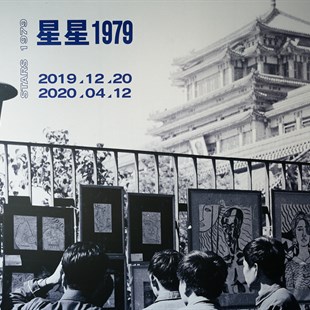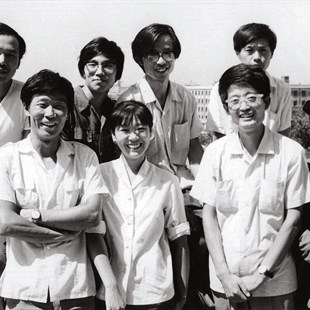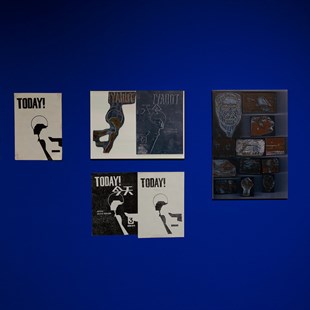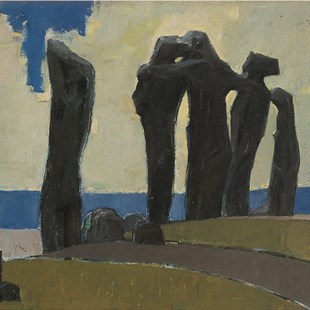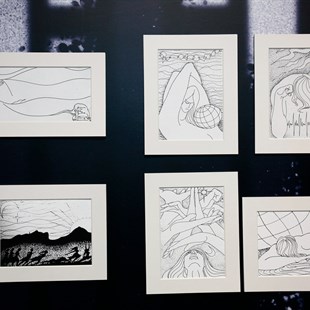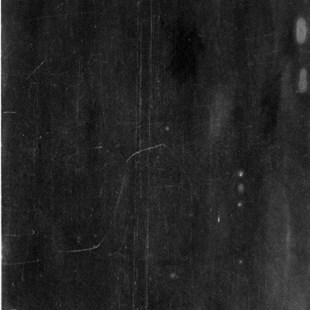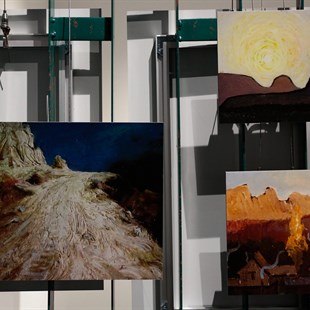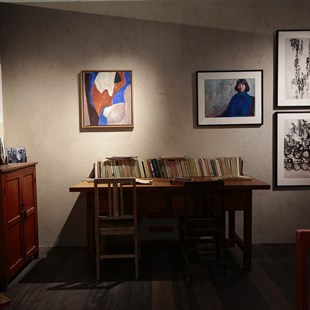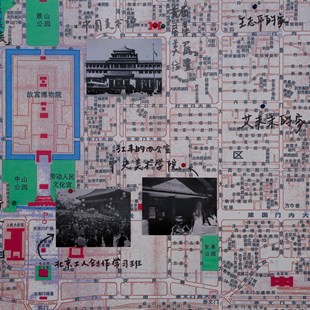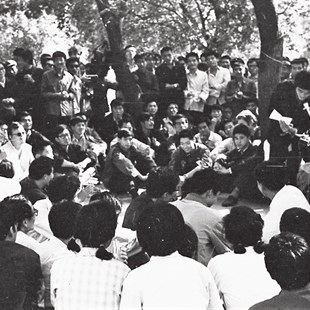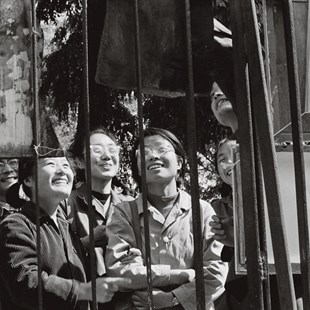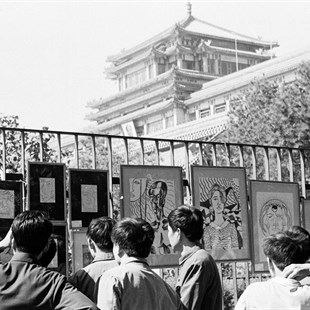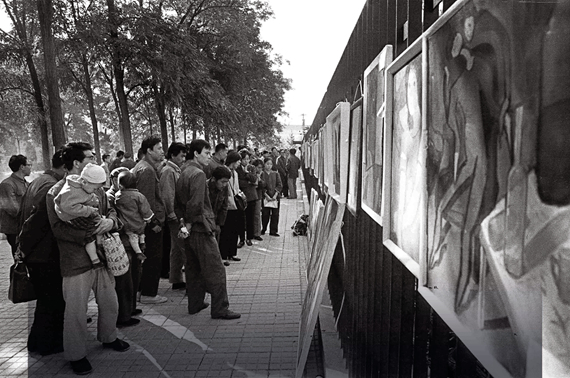
When it comes to the “Stars Group”, most people in the art world are no stranger to this. How is the actual exhibition of the "Stars Group" created? Presumably few people can answer except the participants and witnesses. In the past 40 years after the exhibition, the solo and group exhibitions by the artists from the “Stars Group”, and the retrospective exhibitions on the “Stars Group” have been continuously displayed, but the most realistic retrospective exhibition should be the “Stars 1979” recently opened at the OCAT Institute in Beijing.
At the exhibition site, the “Stars Outdoor Exhibition” in 1979 was restored and more than 130 works are showcased in sequence [1], combining original documents, documentary photos, publications and films, which brings about a retrospective approach to historical reality. The author tried to approach the exhibition from the four key points: “Stars 1979”, Today Magazine, “Compound” and “Outdoor Exhibition”.
I “Stars 1979”
In November 1979, Li Xianting, as a witness and reporter to the “Stars Exhibition”, published the first official report on the “Stars”. The article started from the main points of the exhibition’s organizational form, the social response and the concepts of the works. The summary of the conversation recorded the answers from Wang Keping, Ma Desheng, Huang Rui, and Qu Leilei. Li Xianting also carefully recorded the arguments from the art world at that time: this exhibition is of positive significance for breaking ideological imprisonment caused by the “Gang of Four”. They dare to express their distress and thinking in their own words, and tell the audience about the trauma of their hearts, which should be the product of emancipation of mind. The article finally concludes: “No matter how we evaluate this exhibition, its production and response require further study.” [2] Li Xianting saw the value of “Stars”, but the object he described: “The Stars Exhibition” at the end of 1979, was not exactly the starting point for the study of “Stars”.
In the late 1970s, China’s political culture ushered in its spring and a large number of informal underground folk journals appeared, such as Today, Fertile Soil, Beijing Spring, April Fifth Forum, Exploration, and so on. One day in October 1978, Huang Rui proposed the idea of starting a poetry magazine to Bei Dao and Mang Ke in his home. The three of them hit it off and founded Today magazine. After the magazine was founded, Mang Ke became the core figure and Huang Rui was mainly engaged in the editing work of fine arts. Here, he felt that there was nothing to do and there seemed to be a sense of loss. In his memorial article, he said: “The poets were in the limelight, but those who have painted the blue cover always stay on the blue cover.” Inspired by the open-air exhibition held by the artist Xue Mingde in June of this year, he began to brew new actions and wanted to organize an “an exhibition that can shock the country.” [3]. Huang Rui and Ma Desheng, who traced pictures at the Institute of Mechanical Engineering and illustrated in various civilian journals, put forward this idea. After these two held the inaugural meeting of the art exhibition in the compound at Dongsi Hutong “No. 76”, the preparation work for the exhibition was officially launched. Qu Leilei, Li Shuang, Bo Yun, Wang Keping, Yan Li, Mao Lizi, Yang Yiping and others joined one after another.
In the early summer of 1979, preparations for the exhibition were ready. Huang Rui and Ma Desheng began to apply for exhibition venues with the Beijing Art Association. Liu Xun, the person in charge of the Beijing Art Association, reviewed the works at Huang Rui’s house and immediately agreed to arrange this. But this year’s exhibitions are full, and they can only wait until the following year. The members of “Stars” discussed and finally decided to exhibit in the open air in the street park on the east side of the Museum [4]. At 7am on September 27, 1979, a group nervously set up an exhibition outside the art museum. The exhibition was distributed at 8:20am. The fence of more than 40 meters long was filled with more than 150 oil paintings, ink paintings, woodcuts, and wood carvings. Nearby trees were also full of works [5]. The audience surrounded the exhibition which was beyond their imagination. In this way, the “Stars” were born [6].
II Today Magazine
"This cover has the color of the epoch.” Huang Rui recalled the cover of Today magazine he designed, “At that time, as long as it was printed out and taken to the side of the democracy wall in Xidan, they were immediately sent out. Just this cover was blue. Why? At that time, no books had a blue cover. They were all red and white, but there was no blue. What is blue? Blue is sky. What is sky? It represents Freedom, Infinity. It’s the case in that era.” The original print of the cover of this issue was displayed in the document area of the exhibition. We see the positive and negative male and female images in the blue background as if they are breathing the fresh air in the sky. This section presents us with the interaction between the “Stars” and the literary community “Today”.
At an event in 1992, Bei Dao recalled some past events from the 1970s to the early 1980s. Among them, “the organization derived from it is the ‘Stars Painting Exhibition’.” As one of the founders, Huang Rui did not only design the cover layout for Today, but he also participated in editorial writing and art reviews. Ma Desheng published his short story “Skinny Man” and woodcut in the first issue. Acheng has been a major critic of Today almost from the beginning, commenting on everything. Wang Keping originally appeared as a recitalist at a poetry recital held by Today in 1979. Qu Leilei entered Today with his line drawing in the third issue. Yan Li, who is both a poet and a painter has published poems in Today since its earlier period ... At that time, regardless of the category, as long as they can react to each other, they would come together. [7] From Bei Dao’s perspective, Today and “Stars” were like twin brothers.
In specific works, we can see the similarities between the poets of Today and the painters of “Stars” in their imagery and use of elements. The difference is that they endowed different feelings to the sky. In Huang Rui’s oil painting “Yuanmingyuan:Rebirth”, the ruins stand in a blue sky, which is similar to the cover of Today magazine designed by him. Qu Leilei’s drawings with a marker pen “The Dawns Here Are Quiet” use dots, lines and planes to depict people’s progress under the radiant sky, full of new hope. Ma Desheng’s woodcut print “How Big and Beautiful the Sky Is,” the picture elements are concise, but the strong contrast between black and white highlights the woman’s longing for a scene outside the sky. The poems published by Jiang He in Today magazine have both the image of blue and sky in Huang Rui’s works, and they are exactly the same as the sun and light elements in Qu Leilei’s works:
As long as the sun shines the light to stir the enthusiasm
Labor will be filled with love
Golden wheat, fullness and abundance will approach the sky
Approaching the blue transparent world
In addition, the interaction between Today and “Stars” is also reflected in the use of elements and images such as “Earth” and “Ruins” [8]. For example, Zhao Dalu’s oil painting “Road” and Bei Dao’s poem “Cold Hope” simultaneously depict the images of “sky” and “earth”:
Under the low eaves of the sky
Weaving a gray fence
Countless foamy mushrooms
Filled with potholes on the road
III The Compound
“I rushed to a party to prepare for the exhibition in a few days, the location was in a large compound in East 44th Street, Westinghouse, with mottled walls. The room was full of people, almost all of them were smoking. The smoke filled the outside, there were also people standing outside the house. Whenever they meet a critical point, they crowded to the door.” [9] Acheng recalled the “big miscellaneous compound” described by Huang Rui as “Seventy-sixth”, which is both the home of Liu Nianchun and the meeting place of Today magazine. It is also an important place for the activities of the “Stars” members, carrying the history of “Stars”.
A similar venue is Huang Rui’s home at 64 Baitasi East Street, Xicheng District, Beijing. It is not only the place where Huang Rui negotiated with Bei Dao and Mang Ke to launch Today Magazine, but also concentrated on the “Stars Exhibition”. There is also the home of Zhao Nan, a member of Today, at No. 4 Zhang Zizhong Road, Dongcheng District. On the first Saturday night of each month, a discussion forum for Today ’s works was held here.
The exhibition has created such a private communication place with multiple functional meanings. In this space, thermos and tea cups placed on the tea table, books and poetry collections on the desk, abstract paintings hanging on the wall ... the things used by these star members were reproduced one by one, which created a deep historical scene for us. It echoes the back wall of this space, the artist’s home was marked with pushpins, and together builds the spiritual home of these amateur painters. They gathered or dispersed because of literature and art, which constituted the most authentic humanistic landscape in China at that time.
IV Outdoor Exhibition
The Compound provides a place for the “stars” painters to take part in peaceful activities, but the complete art discourse system also requires public participation. In the main exhibition hall of OCAT, mottled tree shadows and fences full of works take us back to the historical site in 1979. Before the open-air exhibition, the “Stars” were unknown and the participants of the “Stars” were unknown. Why did the “Stars” quickly become famous? In his book published in 2002, Professor Yi Dan of Sichuan University described the invasion of “Stars” from a private space to the Compound, and even to a public space, “Street Park” as a success. This is indeed the case. The open-air exhibition was not initiated by the “Stars”. On March 2, 1979, Xue Mingde held a roving open-air oil painting exhibition at the Xidan Democracy Wall in Beijing. [10] Exhibitions showcased in the park were not started by the “Stars”. In June 1979, the “Unknown Painting Society”, also a non-governmental organization, held the “First Public Painting Exhibition” in Beihai Park, Beijing. “Stars” seem to use these practices as a springboard to complete their heroic breakthrough. This also led to the disputes between “Stars” and these painting exhibitions and the “85’ New Wave” on the “starting point” of Chinese modern art for many years [11].
On the third day of the exhibition outside the National Art Museum of China, the Dongcheng Branch of the Beijing Public Security Bureau closed the Stars Exhibition on the grounds of “affecting the normal life and social order of the people.” In order to obtain the rights to the exhibition, the “Stars” and other folk journalists discussed and decided to hold a protest march on the 30th anniversary of the founding of the People’s Republic of China. After the parade, the detained paintings were returned and the closed exhibition was allowed to resume. From November 23 to December 2 of that year, Stars Exhibition was able to continue to exhibit in Beihai Park. In the summer of 1980, the Stars Art was officially registered in the Art Association. On August 20, 1980, the second Stars Exhibition opened at the National Art Museum of China, which constituted the complete “Stars” event and its following three exhibitions. In 2007, the “Original Point: Retrospective Exhibition of the Stars Art” at the Today Art Museum claimed: “‘The Stars Art held two exhibitions in 1979 and 1980 respectively, and aroused huge social repercussions at that time. This opened the way for Chinese contemporary art. In today’s review and editing of our history, the ‘stars’ are well regarded as the origin of Chinese modern art.”
“Stars 1979” does not attempt to ask and answer this question. It consists of four sections: (1) the social and cultural environment in 1979; (2) the interaction between “Stars” and the literary group Today; (3) the content and form of the first “Stars Exhibition”; (4) Feedback from viewers and “Stars” members to the exhibition; as a focus of discussion, it tried to encourage the development of “Stars” and early Chinese contemporary art through a series of historical reconstructions and conducted further research. The four sections of the exhibition are organically linked to each other, they restore the historical scene as much as possible, from the historical narrative to the artistic ontology.
Chen Danqing mentioned in the article “Review of Retrospective Exhibition” that a museum’s usual display is somewhat focused, missing, incomplete, but it must be balanced by some form of arrangement. Therefore, the message and effect are inevitably partial and one-sided. The intention is to reduce artificial intentions as much as possible, to dilute existing prejudices, and to make the viewer confront with the artist in a more autonomous and authentic way [12]. “Stars 1979” provides us with such an opportunity to face the truth.
“History, for someone, for some people, maybe those parts that cannot be shared with others.”[13]Acheng recalled the summary of the “Stars” past, putting a yoke on the retrospective exhibition of “Stars”. Fortunately, this review has provided us with a prudent and objective reproduction of past readings.
Text by Yang Zhonghui, translated and edited by Sue/CAFA ART INFO
Photo Courtesy of the Organizer
References:
[1] In 1979, the Stars Exhibition actually displayed more than 150 works. The curator of this exhibition, Rong Siyu, introduced that over 20 works was not included in this exhibition for the lack of historical materials.
[2] Li Xianting, “About the ‘Stars Exhibition’”, published in Meishu, Issue 03, 1980.
[3] “Huang Rui Interview Collection”, Today Issue 79, “Special Issue for Today and Stars”.
[4] The location of the exhibition was originally considered to be displayed in front of Xidan, Yuanmingyuan in the western suburbs, and Fuxingmen Broadcasting Building, but all were not ideal. Later they accidentally found a small park on the east side of the Museum, and it was decided. From Yi Dan, History of the Stars, Changsha: Hunan Fine Arts Publishing House, 2002, p. 15.
[5] More than 150 works by 23 artists, and works temporarily suspended by unknown persons constituted the first exhibition of the first Stars Exhibition. The exhibition was vividly recorded because of the photography participation of the April Film Festival. These photos constitute the main literature of our review of the Stars Exhibition.
[6] On the third day of Stars Exhibition outside the National Art Museum of China, the Dongcheng Branch of the Beijing Public Security Bureau closed the exhibition on the grounds of “affecting the normal life and social order of the people”, and the works were detained. In order to obtain the right to the exhibition, “Stars” and other folk journalists agreed to hold a protest march on the 30th anniversary of the founding of the People’s Republic of China at that night. Finally, with the intervention of the Art Association, from November 23 to December 2, the Star Art Exhibition was continued to be displayed in Beihai Park, with a large number of visitors, and more than 9,000 tickets were sold on one day. In 1980, the second Stars Exhibition was successfully exhibited in the National Art Museum of China.
[7] “Interview with Bei Dao”, Today Issue 79, "Today Star Painting Club Special Issue".
[8] For the detailed discussion on the relationship between Today and “Stars”, quoated from Wei Jiayang, “The stars only shine in the dark”: “Stars Exhibition” in the literary “galaxy” (Literature, autumn and winter volume in 2018, Shanghai: Fudan University Press, 2019) and Zhao Yanfen, “Today” (1978-1980): From Works Image to Subject Image” (Yangzhou University 2005 Master’s Degree Thesis.)
[9] Acheng, “Little Stars”, published in Trends Magazine in 1999.
[10] Edited by Liao Yiwu, The Sunken Temple: Photographs of Chinese Underground Poetry in the 1970s, Urumqi: Xinjiang Youth Press, 1999, p. 464.
[11] For academic discussions on the meaning of “Stars Exhibition”, refer to Huo Shaoxia, Stars Artist: Pioneer of Contemporary Chinese Art 1979-2000, Taipei: Artist Press, 2007, page 7-13.
[12] Chen Danqing, “Review of Retrospective Exhibition”, Art Research, 1998, Volume 02.
[13] Acheng, “Little Stars”, published in Trends Magazine in 1999.


